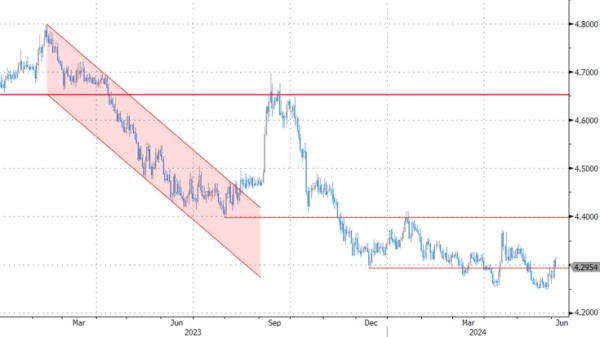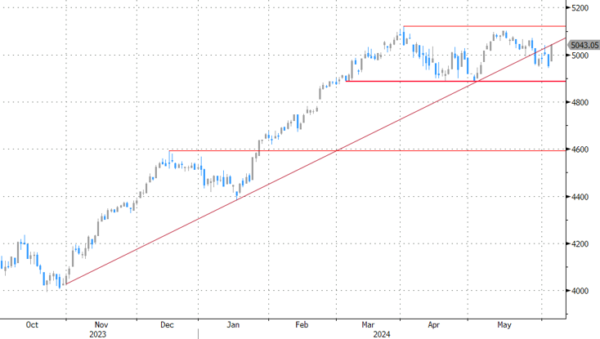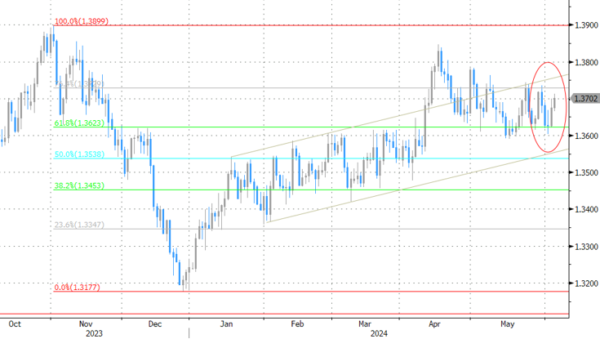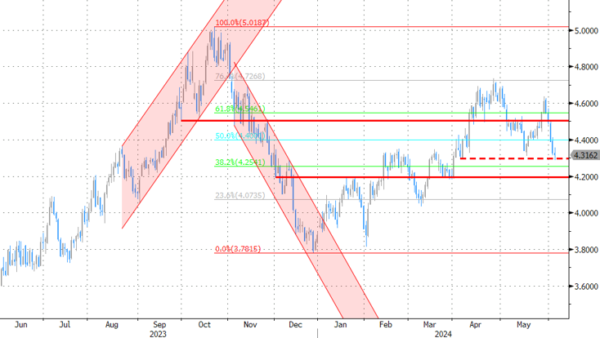Markets
The US 10-yr yield tested 4.31% support after a small miss in May ADP employment change. The US economy added 152k jobs (vs 175k expected) with April figures marginally downwardly revised to 188k (from 192k). The deviation wasn’t big enough to trigger a strong market reaction both because of the solid nature of the job gain and because of the Treasury rally we’ve already had over the past four trading sessions. The chief economist at ADP nevertheless warned that job gains and pay growth are slowing going into the second half of the year with some pockets of weakness already visible tied both to producers and consumers (eg manufacturing firms cut 20k jobs). Wage growth for workers who changed jobs slowed for the second month (to 7.8% Y/Y) while it stayed at 5% Y/Y for those who remained in their job. EUR/USD easily held below the 1.09 resistance area after the ADP, even as risk sentiment turned outright risk-on as well today. Main European stock markets rise up to 1.8% for the EuroStoxx 50.
The Bank of Canada’s first policy rate cut this cycle (4.75% from 5%) triggered a second test of US support levels. BoC governor Macklem said that it is reasonable to expect further cuts if inflation eases. The BoC is seen as a frontrunner in the monetary policy cycle. The test was blocked by a consensus-beating US services ISM. The ISM rebounded from 49.4 (only second monthly
News & Views
Czech April retail sales disappointed. They stagnated (except motor vehicles) compared to March to be up 5.3% Y/Y. Sales of non-food goods rose marginally (0.1% M/M) while sales of food (-0.2%) and automotive fuels (-0.3%) declined in a monthly perspective. Compared to the same month last year, retail trade grew 5.3%, with sales of non-food items 7.1% higher, food sales adding 3.6% and automotive fuels rising 3.9%. Despite a rather slow momentum in retail sales in April, consumer spending is still seen as an important driver for Czech growth further out this year. Solid (real) wage growth data (7% Y/Y nominal, 4.8% Y/Y real) published yesterday in this respect provide hope that the decline in inflation will support Czechs’ real spending capacity. Higher real wage growth and potentially higher domestic spending also support the case for the Czech national bank (CNB) to keep a cautious approach on policy easing. We expect the CNB to slow the pace of rate cuts from this month’s meeting and proceed at this slower pace at the meetings in H2. The risk even is for the CNB to take a pause in its easing cycle toward the end of the year. After rallying from the EUR/CZK 25.40 area to the 24.70 area, the Czech koruna recently settled in a tight sideways range. Still it outperformed regional pears (forint and zloty).
PPI producer prices in EMU in April declined for the sixth consecutive month, easing 1% M/M after a decline of 0.5% in March. Due to less favorable base effects, producer price deflation slowed from -7.6% Y/Y to -5.7%. At first sight this looks still promising for the easing in CPI inflation, too. However, as was the case in many of the previous months, the disinflation process was solely driven by a decline in energy prices (-3.6% M/M from -2.3% M/M in March). PPI ex energy (0.2% M/M) rose for the fourth consecutive month. Prices for intermediate goods (0.3%), capital goods (0.2%), durable consumer goods (0.2%) and non-durable goods (0.1%) all printed in positive territory. In this respect, the PPI data suggest that the deflationary contribution from goods price from last year might be coming to an end.
Graphs
EUR/PLN: zloty awaits tomorrow’s press conference by NBP governor Glapinski after they kept the policy rate unchanged today at 5.75%

EuroStoxx50 rallies back towards cycle high as the impact of growth worries on risk sentiment again proves to be short-lived

USD/CAD: Loonie underperforms after 25 bps rate cut by the BoC with more to come

US 10-yr yield: 4.31% support survives for now, thanks to stronger services ISM










